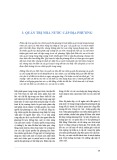
Vol. 7, 2020A new decade for social changeswww.techniumscience.com9772668779000ISSN 2668-7798

The effect of human resources capacity, budget planning,
political budgeting, and public transparency on the of APBD
documents and KUA-PPAS’s synchronization in Musi
Banyuasin district government
Mat Syuroh
College of Social and Political Sciences (STISIPOL) Candradimuka Palembang,
Indonesia
mmatsyuroh@gmail.com
Abstract. This study aims to determine the effect of human resources capacity, budget planning,
political budgeting, and public transparency on the synchronization between Regional Revenues
and expenditures budget (APBD) document and General Policy of Regional Revenues and
Expenditures Budget (KUA) and Provisional Budget Ceiling Priority (PPAS) document. The
population in this study was councilors and officer/staff involved in the preparation of the Work
Plan Budget (RKA) SKPD includes 33 SKPD. The sampling method used census method, where
all the population became the samples is 127 peoples. The data in this study using primary data.
The data obtained were analyzed through multiple linear regression tests. Hypotheses
simultaneously and partially tested by F test and t test. Results of this study showed that
simultaneous variable capacity of human resources, budget planning, political budgeting, and
public transparency has a positive and significant impact on the synchronization between APBD
documents and KUA-PPAS documents. In partial, the capacity of human resources, budget
planning, political budgeting, and public transparency has appositive and significant impact on
the synchronization between APBD documents and KUA-PPAS documents. The implications
of this research can be useful as a conceptual contribution to policy makers, especially in West
Lombok Regency Government and Parliament, in which they should be more consistent and
have a high commitment dealing with budgeting and KUA-PPAS.
Keywords. budget, KUA-PPAS, human resources capacity, budget planning, political budgeting
and public transparency
Introduction
Public sector budgeting is related to the determination of the total allocation funds for
each of program and activity in monetary unit. The process organization budgeting of public
sector is started while the strategy formulation and strategy planning have been completed. The
budgeting steps become very important because the ineffective and not oriented budgeting on
the performance can ruin the arranged plans. The budgeting of public sector is an instrument of
accountability for the management of public funds and the implementation of programs
financed from public money (Mawarni1, Darwanis, 2013). Based on the Regulation of the
Minister of the Interior (Permendagri) number 13/2006, the unified budgeting is the preparation
251
Technium Social Sciences Journal
Vol. 7, 251-262, May 2020
ISSN: 2668-7798
www.techniumscience.com

of an annual financial plan that is carried out in an integrated manner for all types of expenditure
to implement government activities based on the principle of achieving efficient allocation of
funds.
The funding mechanism is including several parties which have the different
background both from the level of understanding and the interests of the budget. These
differences can cause asynchronous in the process of arranging the fund which is the Regional
Government Budget (APBD) document and the document of Public Policy APBD (KUA) and
interim budget priorities and funding ceilings (PPAS). Asynchronous between APBD
documents with the document of KUA-PPAS happened in almost of common occurrence in
most of every local government (Elfrina, Ratnawati, & Wiguna, 2014).
The research by Amirudin 2009 is identifying the factors which influence the sync
between the documents is Human resources capacity, budgeting politic, planning and
supporting information. The results is reveals while when entering the discussion stage the
commissions often found additional activity proposals and requests for a shift in the budget
from one activity to another, which in turn led to differences between the APBD document and
the KUA-PPAS document (Amirudin, 2009)
According to Iskandar 2013, the human resources capacity is the ability of the executive
or legislative member in implementing their respective functions and roles in the process of
formulating policies in regional financial management(Iskandar, 2013). The quality and
capability of Regional Representative Assembly (DPRD) members is also needed so that the
activities set forth in the APBD are truly beneficial to the community. The problem often occurs
is when the budgeting allocation is still understood as the activity of the distribution of
development. Allocation to realize people's welfare has not become a soul in the preparation of
the regional budget APBD. The resources needed is not only comes from the member who has
high education but is also have the member have a good capacity to be able to conduct the roles
and functions that must be carried out properly and optimally. According to Amirudin 2009,
the main legislative role in the in the political process of drafting APBD is related to the
clearance when the discussion KUA-PPAS and in the determination Regional regulation
APBD. In the discussion of funding, the executive and legislative made agreements which reach
for the politic process in KUA and PPAS references before the budget is determined as a local
government so that decisions in allocating complex budgets with budgeting politics that are
believed to cause synchronization in the budget allocation namely between documents of APBD
with KUA-PPAS Document (Amirudin, 2009).
Based on the preliminary observation between APBD and KUA-PPAS in 2014 founds
some problem that faced in the expenditure management of the Musi Banyuasin Regency
Government, among others, understanding and discussion of the APBD is not optimal which is
influenced by not yet effective and efficient APBD approval by the Banyuasin Regency DPRD
and there are still urgent and strategic activities arising from the district, provincial and
government governments the center which was not previously budgeted in the Musi Banyuasin
Regency Regional Budget. This thing can be accommodate directly in RAPBD Musi Banyuasin
district and the level of efficiency and effectiveness of expenditure for each activity carried out
by each SKPD is not yet optimal within the Government of Musi Banyuasin Regency. The
openness to information obtained by the public in APBD planning only at the beginning of the
planning of APBD preparation through Development Planning Conference (musrenbang) at
various levels. In APBD’s implementation stage of APBD management and the final stage of
APBD management information and public involvement are interrupted and not publicly
published, although it is able to published but still cannot be understood simply by the
community, meaning that the public is only involved during the initial APBD deliberations
252
Technium Social Sciences Journal
Vol. 7, 251-262, May 2020
ISSN: 2668-7798
www.techniumscience.com

where the development proposal is based on priority scale directly proposed by the public.
However, the implementation of musrenbang that has been prepared based on priority scale is
not entirely in accordance with the proposal at the time of the musrenbang.
Thus, in the case, researcher is motivated to do this research in order to get the empirical
proof about the influence of human resource capacity, budget planning, budgeting politics, and
public transparency on synchronizing APBD documents with KUA-PPAS, this research is also
accordance with the previous research about APBD document synchronization with KUA-
PPAS Document by Arniatidkk 2010 and Iskandar 2013 moreover, based on the phenomenon
can be seem from budgeting planning that listed to KUA-PPAS as well as the regional
regulation draft on APBD there are differences which lea to inconsistency in RPBD of Musi
Banyuasin Regency.(Arniati & Imelda, 2010; Iskandar, 2013)
Theoretical Framework and Hypothesis Development
Human Resources Capacity
Human resources refers to the peoples in the organization to reach the organization
purpose (Simamora, 2001). According to Irawan(2014), the meaning of human resources is entire
people incorporated in a organization with their respective roles and contributions affecting the
achievement of organizational goals. Human resources must be good enough to obtain a good
human resource capacity as well.
According to Iskandar 2013, the human resources capacity is the ability from the executive
or legislative member in carrying out their respective functions and roles in the process of
formulating policies in regional financial management(Iskandar, 2013). The human resources
capacity is also can be seemed from the extent of the ability of the executive and legislative
branches to play a role in the process of policy making in the management of regional finances.
The executive and legislative roles in the process of formulating policies in regional financial
management, it can be seen from the stages of regional financial management. Based on the
regional financial management guidelines which are divided into three stages including the
preparation, implementation and evaluation of the regional budget APBD. Thus, the resources
needed is not only the member who has high education but also has the good capacity to be able
to implement the roles and functions properly and optimally.
Based on the above framework, a hypothesis formulation can be arranged as follows:
H1: Human resource capacity has a positive effect on synchronizing the APBD Document with
the KUA-PPAS Document.
Budget Planning
Planning can be define as the way organization determines organizational goals
(Mawarni1, Darwanis, 2013). The planning process in preparation budgeting is based on a series
of stages (cycles) that begin in January up to December in the current fiscal year. If the planning
at the initial stage is showing bad results, thus it will have a bad impact on the planning of the
next stage. The good planning is the core from effective management financial. The regional
government cannot get the effective financial management if the system of planning and
funding owned is bad. Therefore, in the first step planning is the decisive factor for
synchronization between RAPBD and KUA-PPAS. In the first planning, the first thing to do is
conducting community aspirations and develops planning meetings (Musrenbang). The citizen
participation is aimed to reach the result in accordance with public interest from the
performance funds.
The funding process management in performance funding started from the work unit
located in Local Government (Pemda), from the budget proposal which is called as Work
253
Technium Social Sciences Journal
Vol. 7, 251-262, May 2020
ISSN: 2668-7798
www.techniumscience.com

Planning and Regional Budget Work Unit Budget (RKA-SKPD). RKA-SKPD then
researched by executive funding team to assess the eligibility of the accommodation in
RAPBD and thus will be submitted to the legislature. Afterward, RAPBD is studied by
legislative funding committee and responded by all commissions and factions in the
discussion of the budget. In this discussion of funding, executive and legislative makes
agreements reached from bargaining (with refer to KUA and PPAS) before the funding
determined as regional regulation. The funding is determined to be the basic legislative to
implement the supervision and evaluation’s function of executive performance in terms of
the accountability of regional heads.
Based on the framework above, a hypothesis formulation can be arranged as follows:
H2: funds planning have positive effect on synchronize the document of APBD and KUA-
PPAS.
Political Budgeting
According to Hague, et al 1998 politic is the activity including the way the group
reaches collective agreement and binding from the effort to reconcile the differences
between the groups. In the governmental view, the politic is connecting with the authority
problem, decision making, public policy and allocation or distribution. Therefore, to carry
out the general policies related to the arrangement and allocation from the resources is
needed power and authority. (Budiardjo, 2008).
Iskandar 2013 stated that politic has significant effect on synchronize the document of
APBD and KUA-PPAS(Iskandar, 2013). In this case, it has purpose to achieve collective goals and
binding with power, decision making, public policy, allocation and distribution in the process of
translating activity plans into financial plans with reference to the KUA and PPAS before the budget
is stipulated as a regional regulation.
According to Halim and Abdullah (2006), in their research on opportunistic legislative
behavior in regional budgeting: The principal agent theory approach, that regional autonomy policy
in Indonesia has brought very fundamental changes to the relationship between the Regional
Government (executive) and the DPRD (legislative). This shows that there is an agency relationship
between the executive and legislative branches.
Dobell and Ulrich (2002) states that the important role of the legislature is to represent the
interests of the community, empowering the government, and overseeing government performance.
These three roles place the legislature capable of having a significant influence on government
policy. There are two possible changes that can be made by the legislature to budget proposals
submitted by the executive, namely: first, changing the amount of the budget and second, changing
the distribution of expenditure in the budget. Based on its role, the executive and legislative also
play a role in budget discussions where the executive and legislative parties make agreements
reached through the political process with reference to the KUA and PPAS before the budget is
determined as a regional regulation in the form of regional budget. Therefore, aside from being an
inseparable unit in the management function, budgeting in government institutions is also
inseparable from the politics of budgeting.
Based on the above framework, a hypothesis formulation can be arranged as follows:
H3: The politics of budgeting has a positive effect on synchronizing the APBD Document
with the KUA-PPAS Document.
Public Transparency
Sopanah and Mardiasmo (2003) stated that transparent budget prepares by the executive
should be able to meet the following criteria:
254
Technium Social Sciences Journal
Vol. 7, 251-262, May 2020
ISSN: 2668-7798
www.techniumscience.com












![20 câu hỏi Quản lý dự án phần mềm có đáp án [mới nhất]](https://cdn.tailieu.vn/images/document/thumbnail/2025/20251003/hieu2004haha@gmail.com/135x160/78791759734259.jpg)


![Tài liệu Quản lý dự án: Kiến thức nền tảng toàn diện [chuẩn SEO]](https://cdn.tailieu.vn/images/document/thumbnail/2025/20250910/kimphuong1001/135x160/92631757496585.jpg)










